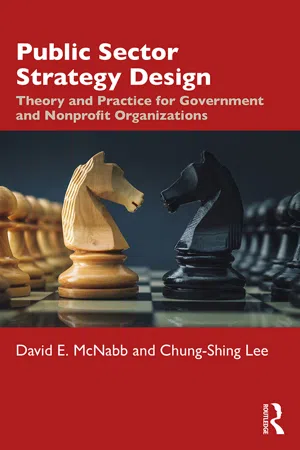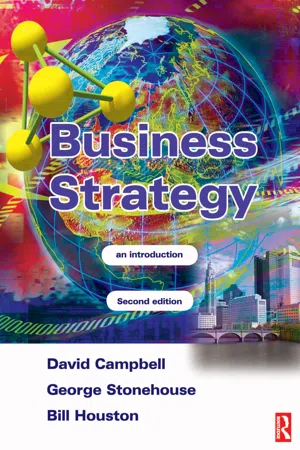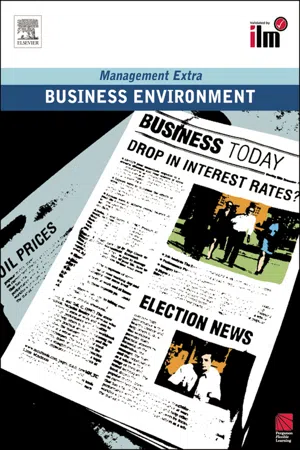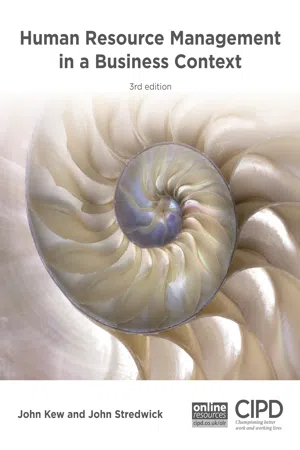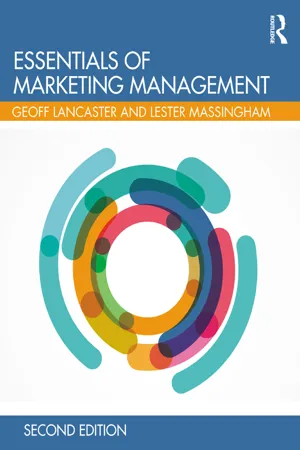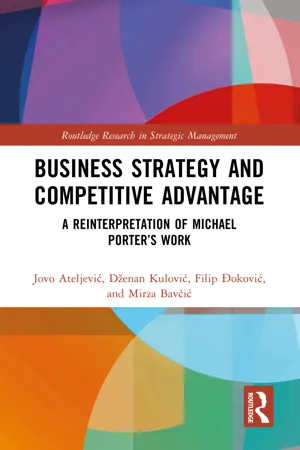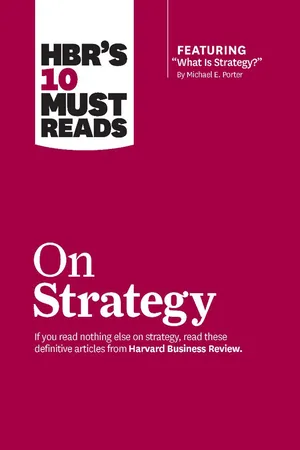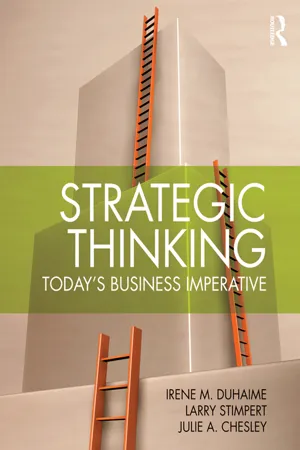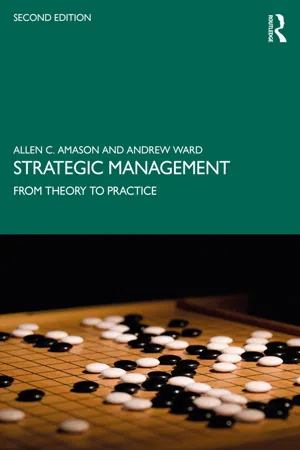Business
The Five Forces Framework
The Five Forces Framework, developed by Michael Porter, is a tool used to analyze the competitive environment of an industry. It focuses on five key forces that shape competition: the threat of new entrants, the bargaining power of buyers, the bargaining power of suppliers, the threat of substitute products or services, and the intensity of competitive rivalry. This framework helps businesses understand the dynamics of their industry and develop effective strategies.
Written by Perlego with AI-assistance
Related key terms
Related key terms
1 of 4
Related key terms
1 of 3
12 Key excerpts on "The Five Forces Framework"
- eBook - ePub
Public Sector Strategy Design
Theory and Practice for Government and Nonprofit Organizations
- David E. McNabb, Chung-Shing Lee(Authors)
- 2020(Publication Date)
- Routledge(Publisher)
PART IIFrameworks for Designing Strategy
Passage contains an image
4 THE COMPETITIVE FORCES FRAMEWORKThe competitive forces framework (also known as the strategic positioning approach or as Porter’s five forces approach) to strategic management developed. Credit for introducing the framework is given to Michael Porter, who in 1979 and 1980 emphasized the importance of managing an organization’s value chain and adoption of a competitive positioning in the marketplace. The five forces that Porter said make up an organization’s competitive environment are: (1) the firm’s competitive rivalry, (2) the power of its suppliers, (3) the power of buyers of the organization’s goods or services, (4) the threat of substitute products, and (5) the threat of new suppliers entering the market. The five forces are all external environment factors. Porter then named four types of generic strategies that organizations adopt to deal with these forces: differentiation, cost leadership, cost focus, and differentiation focus. Many alternative strategies have been added since the 1980s, including a combination strategy, innovation strategy, technology strategy, learning strategy, and others.Writing on game theory as studied in economics, Samuelson and Nordhaus (1985) saw the variety in the paths followed by researchers in the social sciences as different not so much by what the researchers studied, but by how they studied their subject. The same idea can help explain the differences in the organizing frameworks preferred by researchers in public sector management. The framework followed for several decades beginning in the 1970s was patterned after the private sector’s competitive advantage concept and how to adjust operating in a competitive environment to public sector operations.The competitive forces framework was developed as a means of analyzing the competitive environment faced by a firm in a given industry. The approach has also been modified for use for in-depth analysis of a public sector organization’s operation environment. In both applications, designing strategy using the Porter five forces framework is generally conducted after a SWOT environmental analysis. The applications process includes the following seven steps. - eBook - ePub
- George Stonehouse, Bill Houston(Authors)
- 2003(Publication Date)
- Routledge(Publisher)
Figure 7.1 ) it is important to identify which of the five forces are the key forces at work in an industry at any given point in time. In many cases, it transpires that one or more of the five forces prove to be ‘key forces’ and the strategic analysis must focus on these if it is to use the framework fruitfully. The dynamic nature of the competitive environment (meaning that it is constantly changing) means that the relative strength of the forces in a particular industry will change over time. It is therefore important that the five forces analysis is repeated on a regular basis so as to detect such changes before competitors and allow an early adjustment of strategy. Before any conclusions can be drawn about the nature of competition within an industry each of the five forces must be analysed in detail.We will now discuss each of the five forces in turn.Figure 7.1 Porter's five forces framework (adapted from Porter, 1980).Force 1: The threat of new entrants to the industry
The threat of entry to an industry by new competitors depends upon the ‘height’ of a number of entry barriers. As a rule of thumb, the lower the entry barriers to an industry are, the more competitors will be players in the industry. Barriers to entry can take a number of forms.The capital costs of entry
The size of the investment required by a business wishing to enter the industry will be an important determinant of the extent of the threat of new entrants. The higher the investment required, the less the threat from new entrants. The lower the required investment, the greater the threat.Regulatory and legal constraints
Industry regulation varies. Some industries, such as energy, pharmaceuticals and defence equipment, are subject to a complex regulatory framework whereas others are less so. In some industries, regulation concerns health and safety, product handling and licences to operate, export, set up new facilities, etc. Each regulatory or legal permission or restriction is capable of acting as a barrier to entry. - eBook - ePub
- Elearn(Author)
- 2009(Publication Date)
- Routledge(Publisher)
Analyse the competitive nature of your industry and carry out a Five Force analysis
◆ Porter’s Five Force model seeks to evaluate the competitive situation within an industry. The forces are:– bargaining strength of suppliers – threat of new entrants – bargaining strength of buyers – threat of substitute products – competition among existing industry businesses.Consider benchmarking as an industry analysis tool
◆ Benchmarking is a tool to help improve performance by looking outside the organisation at best practices, systems, technologies and business processes.◆ Benchmarking involves examining your own practices, analysing the practices of the organisations that are ahead in the sector, identifying areas for improvement and developing plans to close the performance gap.More @
Campbell, D., Stonehouse, G. and Houston, B. (2002) 2nd edition, Business Strategy: an Introduction , Elsevier Butterworth-HeinemannThis is an accessible textbook that provides a straightforward and comprehensive guide to complex issues and concepts. See Chapter 7 ‘Analysis of the competitive environment’ and Chapter 8 ‘Competitive advantage: strategies, knowledge and core competences’.Porter, M. E. (1980) Competitive Strategy: Techniques for Analysing Industries and Competitors - eBook - ePub
- John Kew, John Stredwick(Authors)
- 2016(Publication Date)
- CIPD - Kogan Page(Publisher)
The economic theory of market structure, distinguishing perfect and monopolistic competition, monopoly and oligopoly, provides a powerful but inevitably simplified model. The real industrial world is much more complex. One important model which attempts to match this complexity is Michael Porter’s Five Forces model of competitive rivalry (Porter 1980).According to the model, the structure of competition in an industry can be described in terms of five major forces. These are:- the threat of entry of new firms
- the power of buyers
- the power of suppliers
- the power of substitutes
- the intensity of rivalry among existing forms.
Each of the five forces is itself determined by a number of different factors. When the five forces are completely analysed, this determines how attractive the industry is to firms within it, and those who might wish to enter it.Unlike economic models, the value of this model lies not in its predictive ability, but in the way in which it provides a checklist whereby particular firms can clearly analyse and define their own position in relation to their own industry. It is a tool which can be used as the first stage of strategic analysis.The threat of entry
The threat of entry of new firms to an industry depends on the extent of barriers to entry. These include:- Economies of scaleSome industries have very high economies of scale – unit costs of output fall considerably as output increases, as in the car industry or the aircraft industry. Others have very low economies of scale, for example estate agency. A new firm seeking to enter an industry with big economies of scale must either buy a high market share on entry or suffer a cost disadvantage. Economies of scale are measured by the concept of Minimum Efficient Scale (MES), or the market share which is necessary to compete at minimum unit cost. It is also possible to calculate the cost penalty incurred by producing at below this volume. However, note first that globalisation has meant increasingly that what is significant is not share of the UK market, but share of a world market, and secondly, that lean production and flexible manufacturing techniques like Just in Time have somewhat reduced the importance of economies of scale.
- eBook - ePub
- Geoffrey Lancaster, Lester Massingham(Authors)
- 2017(Publication Date)
- Routledge(Publisher)
Both the number of competitors and the degree of product differentiation are important facts of competitive industry structure. Useful though this framework is, it is generally recognized that it yields only a partial view of competitive forces at work in an industry, so planners need to look to some of the more comprehensive frameworks of industry analysis.The Porter framework of competitive industry structure
One of the most useful frameworks for analysing competitive structure is that developed by Michael E. Porter,8 who suggests that competition in an industry is rooted in its underlying economic structure and goes beyond the behaviour of current competitors. The state of competition depends on five basic competitive forces, shown in Figure 14.6 . Together, these factors determine the ultimate profit potential in an industry where profit potential is measured in terms of long-run return on invested capital. Not all industries have the same potential. Forces range from intense, with no spectacular returns available – such as tyres, paper, steel – to mild, with high returns being common – such as cosmetics, toiletries, soft drinks.Traditional view of competitive industry structureFigure 14.5The goal of competitive strategy is to find a position in the industry where the company can best defend itself against these forces, or can influence them in its favour. Knowledge of these underlying pressures highlights critical strengths and weaknesses of the company, shows the position in the industry, clarifies areas where strategy changes yield the greatest pay-off and highlights areas where industry trends hold greatest significance as opportunities or threats. Structure analysis is fundamental for formulating competitive strategy.The five competitive forces in Porter’s model
As suggested earlier, the five competitive forces suggested by Porter jointly determine the intensity of industry competition and hence profitability. As Figure 14.6 - eBook - ePub
Strategic Analytics
Integrating Management Science and Strategy
- Martin Kunc(Author)
- 2018(Publication Date)
- Wiley(Publisher)
4 Industry DynamicsObjectives
- To define the structure of the industry
- To learn the impact of the Five Forces on the dynamic behavior of the industry
- To identify analytic tools to manage the behavior of the actors in the industry
Learning outcomes and managerial capabilities developed
- To apply the Five Forces to analyze the industry
- To manage the dynamic behavior of industry actors
As the environment is important to an organization's existence, strategic issues identified within this context will enable an organization to gain advantage over its competitors. It is suggested that through the analysis of the five competitive forces: bargaining power of suppliers; bargaining power of buyers; threat of new entrants; degree of rivalry; and threat of substitutes, a strategist can evaluate the current industry structure, profitability and attractiveness. Within this framework the organization is viewed as a bundle of strategic activities aiming to adapt to industry environment by seeking an attractive position in the market arena.This chapter is based on Porter's Five Forces framework but focuses on employing a dynamic perspective to consider all potential strategic interactions within each force. The dynamic analysis brings into consideration strategic actions such as competitive action/response sequences. Strategic interaction analysis is supported by a set of management science tools like revenue management and system dynamics simulation. Dynamic managerial capabilities are necessary to anticipate and influence other actors in the industry (competitors, buyers, suppliers, new entrants, and substitutes) in order to generate opportunities and reduce threats.4.1 Defining the Industry
Before analyzing the industry, it is necessary to define the structure of the industry. While there are different authors offering suggestions on how to define it, the common ground is reflected in the following questions: - eBook - ePub
Business Strategy and Competitive Advantage
A Reinterpretation of Michael Porter's Work
- Jovo Ateljević, Dženan Kulović, Filip Đoković, Mirza Bavčić(Authors)
- 2023(Publication Date)
- Routledge(Publisher)
Milisavljević, 2012 ): (1) Production broadness and (2) geographical broadness. The accent is on identifying the industry with good future opportunities.In order to occupy an optimal strategic position in the environment as a form of strategic behaviour leading towards the creation of sustainable competitive advantage, Michael Porter (2008) recommended the concept of five competitive forces. The concept provides a way of conducting the company analysis versus environment analysis to form future business strategies in the company-environment interaction.Namely, Michael Porter (1983) believes that the main goal of the analysis is to locate the strategic position in the industry where a company can have the best and most successful defense against the influence of other competitors in the industry and/or where it can have the best influence on them for their long-term benefit. The mutual power of the five competitive forces determines the basic potential of industry profitability and defines the inter-industry differences in the scenario of above the average profitability. The most powerful competitive forces prevalently determine the profitability of an industry.On the one side, the profitability of an industry is higher if an industry has a stable competitive structure, a more favourable position in relation to suppliers, buyers and substitute industries and a lower degree of danger caused by the entrance of other companies. On the other side, the profitability of an industry is lower - eBook - ePub
Managing Strategy
Your guide to getting it right
- Chartered Management Institute(Author)
- 2014(Publication Date)
- Profile Books(Publisher)
Examine your positioning strategy and the differentiation that will set you apart from the competition. Porter’s five forces model may be a useful tool for considering your competitive position within a new market. The five identified forces can be used to determine the relative attractiveness of the market and whether you can successfully compete within it.Consider the impact of the following:- entry into the market of new competitors
- the threat of substitutes offering cheaper alternatives
- the bargaining power of buyers or customers
- the bargaining power of suppliers
- the level of competition from existing competitors.
- the market is fairly static, with little room for growth
- costs are fixed
- your product differentiation is low
- economies of scale are low
- competitor rivalry is fierce, e.g. competitors are undercutting each other in order to secure custom
- you lack the required skills and knowledge to compete
- you lack the required resources in terms of staffing, time and finances.
Contemplate the implications of potential risks and decide how these can be minimised. Risks may be overcome simply by making adjustments to your current operations, or by delaying the time of entry to a more opportune moment. Conversely, you may decide that the risks are simply too great.11 Analyse the data and report your findingsOnce all the information has been gathered and collated, the findings need to be carefully analysed, with rational conclusions drawn. The data will inform decision-making, so it is important to spend the time and effort needed to interpret the information. Remember to focus on the facts as they are presented – not what you want them to show. Although the findings may well reaffirm previously held assumptions about your target market, they could equally reveal something that you had not foreseen. - eBook - ePub
- Harvard Business Review, Michael E. Porter, W. Chan Kim, Renée A. Mauborgne(Authors)
- 2011(Publication Date)
- Harvard Business Review Press(Publisher)
The Five Competitive Forces That Shape Strategyby Michael E. PorterIN ESSENCE, THE JOB of the strategist is to understand and cope with competition. Often, however, managers define competition too narrowly, as if it occurred only among today’s direct competitors. Yet competition for profits goes beyond established industry rivals to include four other competitive forces as well: customers, suppliers, potential entrants, and substitute products. The extended rivalry that results from all five forces defines an industry’s structure and shapes the nature of competitive interaction within an industry.As different from one another as industries might appear on the surface, the underlying drivers of profitability are the same. The global auto industry, for instance, appears to have nothing in common with the worldwide market for art masterpieces or the heavily regulated health-care delivery industry in Europe. But to understand industry competition and profitability in each of those three cases, one must analyze the industry’s underlying structure in terms of the five forces. (See “The five forces that shape industry competition .”)If the forces are intense, as they are in such industries as airlines, textiles, and hotels, almost no company earns attractive returns on investment. If the forces are benign, as they are in industries such as software, soft drinks, and toiletries, many companies are profitable. Industry structure drives competition and profitability, not whether an industry produces a product or service, is emerging or mature, high tech or low tech, regulated or unregulated. While a myriad of factors can affect industry profitability in the short run—including the weather and the business cycle—industry structure, manifested in the competitive forces, sets industry profitability in the medium and long run. (See “Differences in Industry Profitability - eBook - ePub
- Irene M. Duhaime, Larry Stimpert, Julie Chesley(Authors)
- 2012(Publication Date)
- Routledge(Publisher)
The implicit aim of industrial organization economics has been to understand the structural characteristics that allow industries to deviate from the perfectly competitive “ideal.” Porter’s model adopted the structure-conduct-performance framework, but Porter’s work departed from the traditional industrial organization economics perspective in two significant ways. First, he recognized that if firms could either make their industries less competitive or shield themselves from the competitive forces in their industries, then they could enjoy higher performance. Second, Porter’s approach identified and described five specific “forces” that could be used to evaluate the structural characteristics of an industry. For each of the five forces, Porter identified sets of factors that would determine the presence and power of the force in a particular industry environment.The Five Forces Model is almost always depicted as shown in Exhibit 4.4. Exhibit 4.4 also provides a comprehensive list of factors for evaluating the power or intensity of each of the five forces. The logic behind the model is straightforward: As the intensity of the forces increases, the industry environment becomes more hostile and overall industry profitability will decline. In the following sections, the five forces and the sets of factors associated with each of the five forces are examined in more detail.Exhibit 4.4 The Five Forces ModelThe Threat of Entry
If new rivals can enter an industry relatively easily, then the industry will probably be more competitive and it is less likely that the industry will enjoy a high level of average profitability. For example, the lack of entry barriers allowed retailers like Wal-Mart and Target to become major sellers of toys. As a result of their entry and aggressive pricing strategies into this retail segment, longtime toy retailers FAO Schwarz and KB Toys have been forced into bankruptcy. Thus, it is desirable for incumbent firms—those already in an industry or market segment—to erect barriers to prevent other firms from entering. What factors can serve as entry barriers, minimizing the threat of new firms entering an industry? In general, four types of factors can make entry less likely.The first set of factors can be thought of as cost barriers. For example, if incumbent firms enjoy scale economies, the benefits of experience and learning effects, or privileged access to key raw materials or technologies, then potential entrants will necessarily enter the industry at a serious cost disadvantage. Economies of scale exist when unit costs decline with increases in production as fixed costs are spread over a larger volume of output. Larger firms that can realize economies of scale can enjoy significant cost advantages over smaller rivals. The concept of minimum efficient scale (MES) is closely related to the concept of economies of scale and refers to the level of production that is required in order to produce at the lowest level of average unit cost. Firms operating at MES are operating at a level of output that allows them to enjoy the lowest possible unit costs, as illustrated in Exhibit 4.5. - eBook - ePub
Strategic Management
Theory and Practice
- John A. Parnell(Author)
- 2013(Publication Date)
- SAGE Publications, Inc(Publisher)
The industry life cycle stage should also be identified. As discussed in future chapters, changes in firm- and business-level strategies may be necessary as the industry evolves. Understanding the stage is an important precursor to developing appropriate strategies.The importance of clarifying the industry definition at the outset cannot be overstated. External environmental forces that affect the industry cannot be assessed realistically without a clear definition. In addition, a firm’s relative strengths and weaknesses can be classified as such only when compared to other companies in the industry.Industry Structure ____________________________
Factors associated with industry structure can play a dominant role in the performance of many companies with the exception of those that are their notable leaders or failures.10 As such, one needs to understand these factors at the outset before delving into the characteristics of a specific firm. Michael Porter, a leading authority on industry analysis, proposed a systematic means of analyzing the potential profitability of firms in an industry known as Porter’s five forces model.11 According to Porter, an industry’s overall profitability (i.e., the combined profits of all competitors) depends on five basic competitive forces, the relative weights of which vary by industry (see Figure 3.2):- The intensity of rivalry among incumbent firms
- The threat of new competitors entering the industry
- The threat of substitute products or services
- The bargaining power of buyers
- The bargaining power of suppliers
These five factors combine to form the industry structure, and they suggest (but do not guarantee) profitability prospects for firms that operate in the industry. Each of the factors will be discussed in greater detail. - eBook - ePub
Strategic Management
From Theory to Practice
- Allen Amason, Andrew Ward(Authors)
- 2020(Publication Date)
- Routledge(Publisher)
Other firms may, through regulatory means, try to limit customer options. Cable TV companies, local phone service providers, and power generation firms have all benefited from their status as protected monopolies. While they are subject to considerable regulation and oversight, they are also protected from direct competition. As a result, customers are often left with limited options for cable or power service. In the absence of options, these customers have little or no bargaining power. Indeed, it is to prevent these sorts of suppliers from abusing this bargaining power advantage that these firms and their prices are so carefully regulated. Other firms benefit from legal limitations on competition as well. Companies in the pharmaceutical and biotech businesses often get patents for their products and processes. These patents protect the firms by limiting the ability of competitors to make and sell comparable products. With few if any comparable products available, customers must deal with the patent holder. As a result, the holder of the patent has great bargaining power and great ability to sell more and to sell at a premium price.Bargaining power relates directly to competitive advantage and is a large part of understanding profitability. Firms with much bargaining power are often able to sell more and to sell at a higher price. Firms with little bargaining power must often work harder to make sales and will often sell less or sell at a lower price. Thus, understanding bargaining power and the various forces that govern it is a key part of environmental analysis.THE 5-FORCES MODELFortunately, a considerable amount of time and effort has been devoted to understanding bargaining power. From this work has emerged a simple, yet powerful tool, the 5-Forces model (Figure 4.3 ). Developed by Michael Porter (1980), the 5-Forces model depicts competitiveness or profit potential as resulting from the interaction of 5 forces: the bargaining power of sellers, the bargaining power of buyers, the availability of substitute products, the threat of new entrants, and the rivalry among existing competitors.FIGURE 4.3The Five-Forces ModelBargaining Power of the SellerBargaining power of the seller relates to the attractiveness and availability of particular products and services in relation to available options. Returning to the earlier example, Nike is considered a maker of reliable, high-quality athletic shoes and apparel. That perception translates into bargaining power for Nike. Customers can pay Nike’s price or they can settle for something else, but buying from Nike likely means paying a premium price. Quality then, or perceived quality, produces bargaining power for the seller. Bargaining power for the seller can also relate to the absence of competition. Airline ticket prices are generally higher on routes that are served by only one carrier, for instance (Chen et al., 1992). The importance of the product or service also relates to bargaining power. For example, buyers rarely choose a surgeon based on cost. Because of the importance of the service, customers will generally want the best available provider. To get that provider, they may end up having to wait longer for their procedure, having to pay more for the procedure, or both. Quality, exclusivity, prestige, or importance of the product or service can all shift bargaining power away from the buyer and to the seller by limiting the ability of the customer to walk away and go elsewhere.
Index pages curate the most relevant extracts from our library of academic textbooks. They’ve been created using an in-house natural language model (NLM), each adding context and meaning to key research topics.
Explore more topic indexes
Explore more topic indexes
1 of 6
Explore more topic indexes
1 of 4
